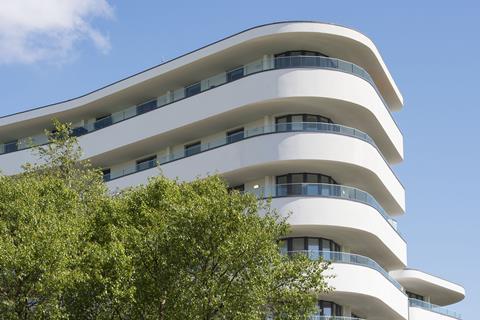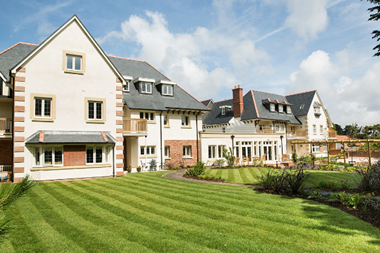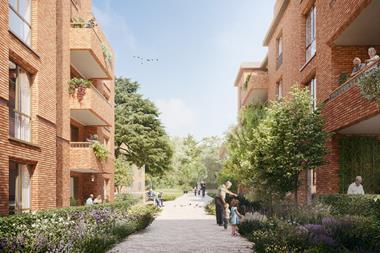“I’m the other half,” says McCarthy & Stone’s Nigel Turner, nodding to his colleague Mike Lloyd. “You can work out which one’s the more attractive.”

“Not sure where you’re going with that, Nige,” says Lloyd, as the duo burst into laughter.
Turner refers to himself and Lloyd as a “double act”, and it’s true in more ways than one. Both were brought in as chief operating officers last January: Turner in charge of land acquisition, planning consents, build and delivery; Lloyd overseeing marketing, sales, service operation and tech.
Their goal was to implement the company’s 2019-23 “transformation strategy”, aimed at steadying the business following a profit warning in 2018. It called for a shift “from growth to increasing returns”, a move towards multi-tenure developments – including rental – and a greater focus on costs.
“We went on a dash for growth,” says Lloyd of the years preceding the new strategy. “We thought if we build more, we’ll sell more. And we did sell more – but we put more cost in than we got revenue out. Our return on capital employed and our margins dropped towards the bottom end of housebuilders. That’s not sustainable.”
The firm’s 2019 full-year financial results, released this January, paint a mixed picture of its progress. Revenue rose 8%, but pre-tax profits dropped 25%. Return on capital employed – its key performance metric – remained steady at 10% (the company wants to hit 15% by 2021). Chief executive John Tonkiss called it a “solid trading performance in a difficult market”.
Rising to the challenge
Clearly, McCarthy & Stone’s turnaround is far from complete. But how far do Turner and Lloyd feel they have come?
McCarthy & Stone attributed its fall in 2019 pre-tax profit to £17m of exceptional costs, including redundancy costs. Around 8% of staff were let go as part of its “rightsizing”. Turner and Lloyd admit it has been a difficult period.
“Because McCarthy & Stone had been growing so much, it hadn’t done any of those downsizing or restructuring exercises [before], so I think it was quite a shock for people at that time, losing colleagues,” says Lloyd.
Equally, Turner says employees realised that change was necessary. That change has been widespread. Alongside redundancies, McCarthy & Stone has expanded the tenure mix within its buildings and is in the early stages of employing modern methods of construction. It has also shifted the types of sites it wants to buy – Turner is particularly interested in repurposing beleaguered retail schemes – and begun trialling resident monitoring tech.
I think it was quite a shock for people at that time, losing colleagues
Mike Lloyd, McCarthy & Stone
“It’s taken a year for us to be able to trust in the business, to be honest, to try and get that change of culture,” says Turner.
It is the rise of rental that is the most eye-catching aspect of the new strategy. The company began offering more flexible tenures, including homes for rent and shared ownership, last March. The aim was to trial rental homes on a dozen sites and find the “secret sauce” before the end of the year, explains Lloyd.
“The thing that’s surprised me is how quickly it took off,” he says. A dozen trial sites turned into a dozen more, and before the end of the year the company had rental units in most of its schemes. “At times it was becoming 15% to 20% of [our] business,” adds Lloyd. “In recent months it’s been a quarter, and we’re not even a year in.”
In the long term, Lloyd believes rental will account for “at least a quarter” of McCarthy & Stone’s units. Could it ever become the most popular tenure? “That feels a bit of a stretch right now, but maybe,” he says. “I certainly think, given where we’ve got to, there’s a model where it’s a third of our business.”
Willingness to rent
Previously, McCarthy & Stone was sceptical about rental accommodation because it believed its customers aspired to home ownership, says Lloyd. But its residents have shown a willingness to rent, rather than own, freeing up cash for them to spend on family, or on holidays.
“When you get to 85, 90, does it really make sense for everybody to invest in another property?” Lloyd asks. Entering a retirement community can feel like a big step, and renting “lowers some of the barriers”, he says.
The company will fund its push into rental with a £300m investment vehicle. In its full-year results, it said it had not yet found a funding partner – an announcement that analysts at Jefferies said failed to “provide quite the progression we hoped for”.

Turner and Lloyd, however, do not want to rush. “We’re deep in the process of talking to potential investors, and we wanted to make sure we get the right offer for us,” says Lloyd. “Because this is new, holding and allowing investors to get under the surface of what we’ve done so far is important, ultimately, to getting a good price. I’m sure we could’ve raised the fund by now, but not at the price we’ll get having gone through that process.”
Turner says the company is not just looking for a financial partner. “We want a partner who’s going to help with the product offering, the way we market it, the way we bring the business forward.”
The shift to rental has a knock-on effect on the types of land deals Turner is pursuing. The company may look to commit to larger sites in future, he says, and in more urban locations than before. He cites the centre of Derby as an example of a location “we traditionally wouldn’t have looked at”, but now seems viable. If rental becomes more popular, McCarthy & Stone could shift its balance of apartments from two bedrooms to one, he says.
High street challenge
Turner is particularly keen on retail sites, and believes that “bringing life and vitality back to challenged high streets should be at the heart of what we’re doing”. Specifically, the company has a requirement to buy more than 70 schemes this year, between one and one and a half acres, close to town centres.
“That old warehouse that’s selling cheap stuff, or a collection of three or four charity shops – a fund will own that; there might be empty office space or apartments above,” he says. “We should be looking at how we redevelop and re-engineer that.”
Another aim of the 2019-23 strategy was to reduce the price of McCarthy & Stone’s homes in order to appeal to a broader demographic. The use of modern methods of construction is core to the change. The company’s 2019 results show it hasn’t yet made much progress on affordability: its average 2019 selling price increased 3% from 2018 to £308,000.
To that end, Turner says the company is discussing potential partnerships with construction companies. “For one [potential partner], everything’s built in a factory and it arrives on site ready to plug and play. The other is 20% of the construction will be fabricated off site.”
We want a partner who’s going to help with the product offering
Nigel Turner, McCarthy & Stone
Modular construction will not reduce build costs immediately, but they will speed up delivery, potentially cutting a 12- to 15-month construction programme to 10 months, says Turner. Combine that speed with increased reliability and more stringent quality control, and the group’s costs should start to come down.
But it could take years before these changes affect the company’s bottom line.
“Our affordability workstream relating to changing the way we build our product is probably on a two-year programme,” says Turner. “We’ve got to identify sites today. We’ve then got to get planning consents, which always takes too long, and then we’ve got to build it and deliver it.”
Turner and Lloyd agree the company is now in a more “settled position”, primed to enact major changes on site. Both are excited about the future, and say that one of the things that drew them to the company was its “social purpose”.
“What we do has a huge amount of social good, and everybody in the business is very proud of that,” says Lloyd. “The thing we hear most from our residents is: ‘I wish I’d done this 10 years ago.’”
No doubt the company’s senior executives are thinking the same thing.





























No comments yet